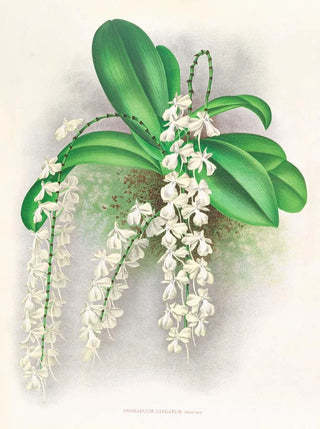Art print | Citrate of Angraecum - Jean Jules Linden


View from behind

Frame (optional)
In the enchanting world of floral art, "Citrate d'Angraecum" by Jean Jules Linden stands out as an iconic piece, revealing the fleeting beauty of nature. This artwork, which evokes the delicacy and richness of tropical plants, transports the viewer to exotic lands, where each petal and leaf seems to vibrate to the rhythm of life. The light plays on the forms, and the colors intertwine with rare harmony, creating an atmosphere that is both soothing and captivating. Contemplating this piece, one feels invited to explore the diversity of flora while being immersed in a world where art and nature meet with infinite grace.
Style and uniqueness of the work
Jean Jules Linden, master of botanical hyperrealism, manages to capture the very essence of the plants he depicts. In "Citrate d'Angraecum," he deploys a palette of vibrant colors that evoke the richness of tropical landscapes. Every detail is meticulously observed, from the veins of the leaves to the subtle nuances of the flowers. This artwork does not merely represent a simple floral subject; it transcends reality to offer a sensory experience. The textures seem tangible, and one can almost perceive the delicate scent of the flowers. Linden succeeds in creating a balance between scientific precision and artistic expression, paying homage to natural beauty while transforming it into a timeless art piece.
The artist and his influence
Jean Jules Linden, born in 1817, is a Belgian painter renowned for his contributions to the genre of botanical painting. His passion for exotic plants led him to travel around the world, collecting specimens and drawing inspiration from the landscapes he discovered. His works, often imbued with romantic sensitivity, testify to an era when nature was both a source of wonder and a subject of scientific study. Linden skillfully combined these two aspects, influencing many artists of his time and beyond. His unique approach paved the way for a new appreciation of botany in art, and his legacy endures in the works of numerous artists.

Matte finish

View from behind

Frame (optional)
In the enchanting world of floral art, "Citrate d'Angraecum" by Jean Jules Linden stands out as an iconic piece, revealing the fleeting beauty of nature. This artwork, which evokes the delicacy and richness of tropical plants, transports the viewer to exotic lands, where each petal and leaf seems to vibrate to the rhythm of life. The light plays on the forms, and the colors intertwine with rare harmony, creating an atmosphere that is both soothing and captivating. Contemplating this piece, one feels invited to explore the diversity of flora while being immersed in a world where art and nature meet with infinite grace.
Style and uniqueness of the work
Jean Jules Linden, master of botanical hyperrealism, manages to capture the very essence of the plants he depicts. In "Citrate d'Angraecum," he deploys a palette of vibrant colors that evoke the richness of tropical landscapes. Every detail is meticulously observed, from the veins of the leaves to the subtle nuances of the flowers. This artwork does not merely represent a simple floral subject; it transcends reality to offer a sensory experience. The textures seem tangible, and one can almost perceive the delicate scent of the flowers. Linden succeeds in creating a balance between scientific precision and artistic expression, paying homage to natural beauty while transforming it into a timeless art piece.
The artist and his influence
Jean Jules Linden, born in 1817, is a Belgian painter renowned for his contributions to the genre of botanical painting. His passion for exotic plants led him to travel around the world, collecting specimens and drawing inspiration from the landscapes he discovered. His works, often imbued with romantic sensitivity, testify to an era when nature was both a source of wonder and a subject of scientific study. Linden skillfully combined these two aspects, influencing many artists of his time and beyond. His unique approach paved the way for a new appreciation of botany in art, and his legacy endures in the works of numerous artists.






